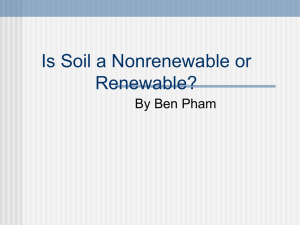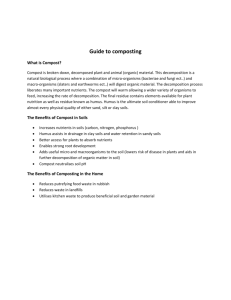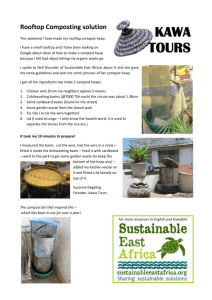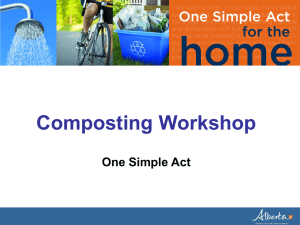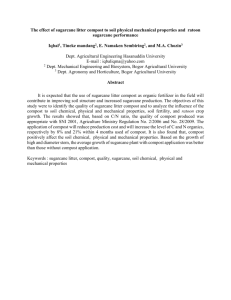Trial details - Department of Agriculture and Food
advertisement
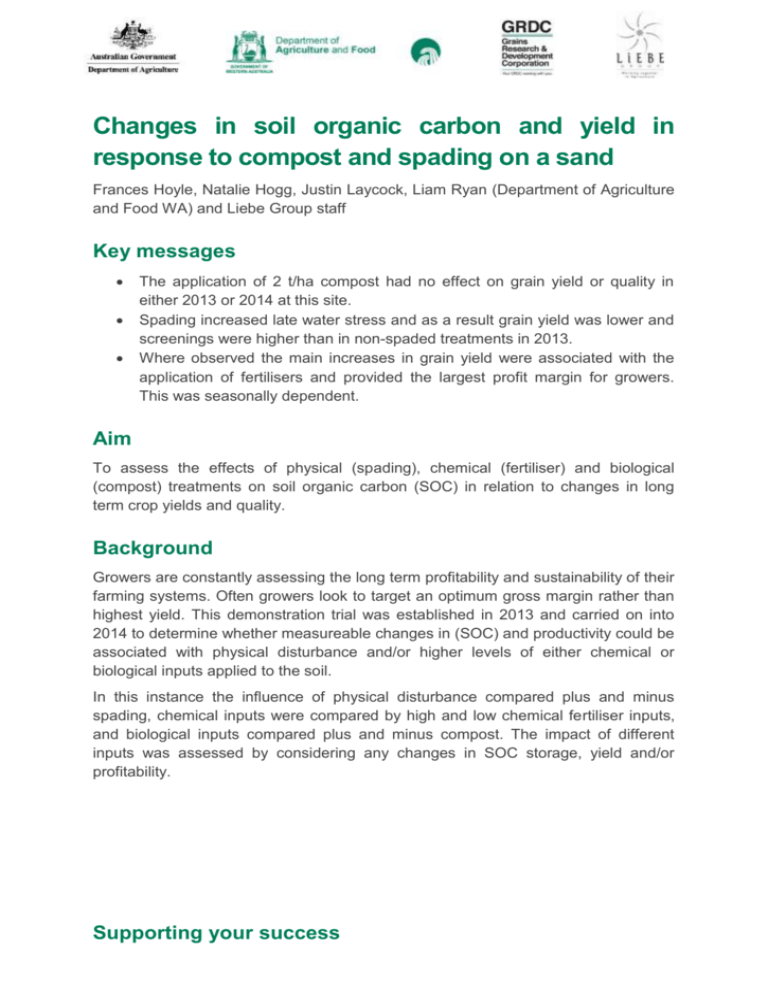
Changes in soil organic carbon and yield in response to compost and spading on a sand Frances Hoyle, Natalie Hogg, Justin Laycock, Liam Ryan (Department of Agriculture and Food WA) and Liebe Group staff Key messages The application of 2 t/ha compost had no effect on grain yield or quality in either 2013 or 2014 at this site. Spading increased late water stress and as a result grain yield was lower and screenings were higher than in non-spaded treatments in 2013. Where observed the main increases in grain yield were associated with the application of fertilisers and provided the largest profit margin for growers. This was seasonally dependent. Aim To assess the effects of physical (spading), chemical (fertiliser) and biological (compost) treatments on soil organic carbon (SOC) in relation to changes in long term crop yields and quality. Background Growers are constantly assessing the long term profitability and sustainability of their farming systems. Often growers look to target an optimum gross margin rather than highest yield. This demonstration trial was established in 2013 and carried on into 2014 to determine whether measureable changes in (SOC) and productivity could be associated with physical disturbance and/or higher levels of either chemical or biological inputs applied to the soil. In this instance the influence of physical disturbance compared plus and minus spading, chemical inputs were compared by high and low chemical fertiliser inputs, and biological inputs compared plus and minus compost. The impact of different inputs was assessed by considering any changes in SOC storage, yield and/or profitability. Supporting your success Trial details (List of abbreviations available at end of document) Detail Property Plot size and replications Soil type Paddock rotation Treatments Description Long term research site, Buntine 50m x 18.2m x 4 replications Deep yellow sand (Tenosol, 13% clay 0-30 cm) non-repellent 2012 canola, 2011 wheat , 2010 wheat 1 Low fertiliser - control 2 High fertiliser 3 Spading 4 Compost 5 Fertiliser + spading 6 Spading + compost 7 Fertiliser + compost 8 Fertiliser + compost + spading Activity 2013 2014 Crop type Sowing date Seeding rate Barley- Roe 5 June 60 kg/ha 209mm Oats- Brusher (cut for hay) 6 May 78 kg/ha 159mm (May-October) 129mm (includes consideration of summer rainfall and losses due to evaporation and run-off) 6 May: 2.L/ha SpraySeed 0.5L/ha Diuron 0.5L/ha Dual Gold 30 June: 500g/ha Diuron 140g/ha Cadance 1% Hasten 10 L/ha Flexi-N 9 L/ha Calsap 25 kg/ha Urea top dressed 34 kg/ha TSP 50 kg/ha Urea top dressed 80 kg/ha TSP Growing season rainfall 21 May: 5 June: Herbicide 10 Oct: 2L/ha glyphosate 2L/ha SpraySeed 2.5L/ha Boxer gold 130g/ha Metribuzin 2L/ha Reglone Nil Fertiliser – low treatment Fertiliser – high treatment Compost treatment Spading treatment 80 kg/ha Triple Super Phosphate (TSP) at sowing 40 kg/ha urea at tillering 2 t/ha Rotary spading on 17 May Nil Nil Results 2013 Grain yield In 2013 the control (non-spaded) treatment yielded 15% more than spaded treatments (2.2 t/ha and 1.9 t/ha respectively). Grain protein was lower (9.6% versus 11.3%) resulting in approximately 35 kg/ha uptake for both treatments. High screenings on the spaded treatment (42% screenings < 2.5mm) suggests this treatment may have experienced higher water stress later in the season and may explain the slightly lower grain weight compared to non-spaded treatments (30% screenings < 2.5mm). This would be supported by seasonal observations that crop height and biomass were greater in spaded treatments than non-spaded treatments. Table 1 Average grain yield and quality responses for Roe barley to treatments imposed (data is the average of spaded and non-spaded areas). Grain yield (t/ha) 1.95 Protein (%) 9.1 N Uptake (kg/ha) 30 Hectolitre weight (kg/hl) 66 Screenings (%) 27 Compost 1.81 10.1 30 64 37 Fertiliser 2.28 11.1 42 64 38 Compost + Fertiliser 2.15 11.5 41 63 42 LSD (p<0.05) 0.25 0.6 ns 1.5 11 Treatment Control Compost did not alter grain yield, grain protein or Nitrogen (N) uptake compared to the control treatment (Table 1). Adding inorganic fertiliser did increase the amount of nitrogen in the crop and had a N fertiliser use efficiency of 66% in this instance (Table 2). The addition of compost with fertiliser did not result in any further gains. 2014 Soil No change in nutrient status was measured in 2014 as a result of treatments imposed in 2013 (Table 2). Cation exchange capacity (CEC) was evenly distributed across all soil layers in spaded treatments compared to non-spaded treatments, where more than 50% was in the surface 0-10cm. This suggests changes in CEC are associated with the burial of organic matter that was previously located in the topsoil. Changes in soil pH were evident as a result of spading across all soil depths and resulted in a profile which should arguably support higher productivity (Figure 1). Surface (0-10cm) pH decreased by approximately 0.5 units in spaded treatments, but increased at 10-20cm (0.7 pH units) and 20-30cm (0.5 units) taking these layers above the minimum pH of 4.8 recommended for these soil layers. Table 2 Soil properties (0–30 cm) measured in March 2014 – 12 months after treatments were imposed at Buntine. Data is the average of all treatments. Depth N P K S CEC (NH4, (Colwell (Colwell (mg/kg) (meq/ NO3; mg/kg) mg/kg) 100g) mg/kg) OC (%) OC pH BD (t/ha) (CaCl2) (g/cm3) C/N ratio 0-10 10 23 66 31 2.8 0.6 9.1 5.8 1.5 10 10-20 6 23 56 25 2.0 0.5 8.7 5.1 1.7 10 20-30 3 12 58 21 1.5 0.3 5.1 4.8 1.6 8 (cm) A large (p<0.05) decline in dissolved organic carbon of 39% was observed in spaded treatments, as well as a 60% decline in microbial biomass carbon (81 kg/ha) and 57% decline in potentially mineralisable nitrogen (6 kg/ha) compared to area that were not spaded. 4.0 Soil pH (CaCl2) 5.0 6.0 7.0 Soil depth (cm) 0 5 10 15 20 25 30 Figure 1 Soil pH profile (as measured in CaCl2) for control (■) and spaded (○) treatments to a depth of 30 cm as measured in 2014 (data is the average of all compost and fertiliser treatments) Soil organic carbon stocks (0-30cm depth) averaged 22.4 t C/ha in treatments which had no spading applied and 19.0 t C/ha in spaded treatments indicating a significant decrease of approximately 15%. The surface layer (0-10cm) where most organic matter is located experienced the greatest losses with the spaded treatment approximately half that of non-spaded treatments (SOC 0.4% versus SOC 0.8%). It appears a component of this was lost and the remainder redistributed to the 20-30cm soil layer which measured an increase in SOC (0.4% SOC versus 0.2% in non-spaded areas). No other treatment differences were measured as a result of either increased fertiliser or from applying compost (Figure 2). Soil organic carbon stocks (t C/ha) 15 12 9 6 3 0 Compost Fert Fert+compost Nil Compost SPADED Fert Fert+compost Nil UNSPADED 0-10cm 10-20cm 20-30cm Figure 2 Effect of spading, compost and fertiliser application on soil organic carbon (t C/ha) measured in 2014 at depths of 0-10, 10-20, 20-30cm Hay yield No significant changes in hay yield were measured at this site associated with treatments. A rainfall to yield conversion suggests approximately 15kg of hay yield per mm of growing season rainfall (May to October rainfall, plus one third of JanuaryApril rainfall) was achieved taking into consideration some loss of water through runoff and evaporation (one third of total growing season rainfall). Oat hay yield (t/ha) 2.5 2.0 1.5 1.0 0.5 0.0 Compost Fert Spaded Fert+compost Nil Unspaded Figure 3 Effect of treatments applied in 2013 on oat hay yields in 2014 Economic analysis In 2013 and 2014 the application of 2 t/ha compost did not result in higher returns, and the response under compost plus fertiliser treatments could be attributed to the application of fertiliser. In addition, spading at this site did not return any further gains in terms of total returns based on grain yield and quality in either season. The high cost of spading and compost negatively influenced short term profit outcomes in 2013 (Figure 4) and responses observed in both 2013 and 2014 suggest these treatments are unlikely to pay for themselves over the longer term at this site. 300 250 1 Unspaded Control (nil fertiliser or compost) 200 2 Unspaded Fertiliser (80 kg/ha TSP, 40 kg/ha urea) Gross margion ($/ha) 150 3 Spaded Control (nil fertiliser or compost) 100 50 4 Unspaded Compost (2 t/ha) 0 5 Spaded Fertiliser (80 kg/ha TSP, 40 kg/ha urea) -50 -100 6 Spaded Compost (2 t/ha) -150 7 Unspaded Compost + Fertiliser -200 -250 8 Spaded Compost + Fertiliser 1 2 3 4 5 Treatment 6 7 8 Figure 4 Gross margins ($/ha) for soil treatments applied to barley in 2013 on a deep sandy soil at Buntine (Source: Nadine Hollamby, Liebe Group) Thus in this instance the most profitable treatments would have been the nonspaded control (Treatment 1) and the non-spaded fertiliser (Treatment 2; Figure 1) and reflects 2014 yield (Figure 4) and quality results (not presented) in which no differences between treatments were measured. The only measureable changes in soil condition noted in 2014 that would add value to the potential long term profit of this site was increasing soil pH at depth associated with spading. Comments Machinery used for composting caused some compaction and under dry post-sowing conditions as experienced in 2013 can cause patchy germination. In 2013 the trial site experienced significant moisture stress early in the season and may not be representative of seasons experiencing an average or wetter start. Extended moisture in spring supported good yields associated with high grain weights. In 2014 the site had good starting moisture and rainfall but experienced dry post sowing conditions through June and July. This site has not responded greatly to fertiliser suggesting nitrogen was not a limiting factor in either season. Soil tests taken in March also suggest there would be no other limiting major nutrients (phosphorous, potassium, sulphur) to crop growth. The control treatments which had a minimum fertiliser and background turnover of soil organic matter (assumed at 3% per year) could have been expected to supply between 65 and 80 kg N/ha. Application of compost at 2 t/ha is nominal given the background SOC stocks of approximately 20 t/ha (0-30cm). To have an impact on soil function the rate of application required is likely much greater and would need to be maintained and applied at regular intervals to avoid losses. Abbreviation Meaning g/ha kg/ha t/ha L/ha kg/hl mg/kg g/cm3 mm Kg C/ha N/ha TSP LSD CEC N NH4 NO3; P K S OC CaCl2 BD C/N ratio N/ha Gram per hectare Kilogram per hectare Tonne per hectare Litre per hectare Kilogram per hectolitre Milligram per kilogram Gram per cubic centimetre Millimetre Kilogram Carbon per hectare Nitrogen per hectare Trisodium phosphate Least significant difference Cation exchange capacity Nitrogen Ammonium Nitrate Phosphorus Potassium Sulphur Organic carbon Calcium chloride Bulk Density Carbon Nitrogen ration Nitrogen per hectare Acknowledgements Thanks to the Liebe Group and their growers for continued interest and support for this project and management of the trial site. Also thanks to Richard Bowles (University of Western Australia) for trial site sampling and analyses. This project is led by the Department of Agriculture & Food WA (DAFWA) in collaboration with the Liebe Group and is supported by funding from the Australian Government Department of Agriculture - Action on the Ground program and the Grains Research and Development Corporation (GRDC). Contact: Frances Hoyle frances.hoyle@agric.wa.gov.au

